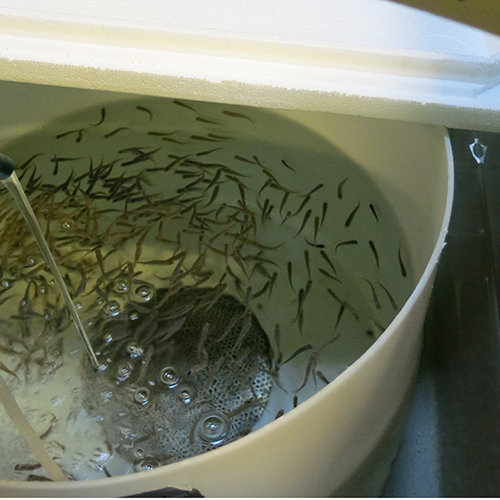First feeding behavior: A potential tool to select robust trout for organic aquaculture
The RobustFish project is testing the selection of trout larvae according to their developmental rate in order to obtain fish that are naturally more robust against stress and disease for organic aquaculture.

The preliminary results in the RobustFish project show that a developmental trait in rainbow trout larvae, the emergence time for first feeding behavior, could be a promising criterion to select fish naturally more robust against stress and disease to be used in organic aquaculture.
Emergence time
Salmonid larvae pass their first months of life hidden in the gravel in the places where they are hatched, while they are consuming the nutrients present in their yolk sac. When their yolk sacs are consumed or almost consumed the fish develop a typical swim-up behavior, and they move towards the surface in order to look for food for the first time.
In wild salmonids, the time required for each individual larva to develop the typical swim-up behavior, the “emergence time”, correlates with the future ability of the fish to handle stress. Usually, the fish that emerge earlier are less sensitive to stressors and are able to grow at higher rates than fish that need more time to develop the swim-up behavior. The main objective of one of the work packages of the RobustFish project is to take advantage of that in order to obtain fish that are more robust against stress and disease.
Selecting trout larvae in the hatchery
In order to select larvae according to their emergence time a special device was developed at DTU Aqua: It consists of artificial gravel made of golf balls where the fish are placed just after hatching. When the fish consume their yolk sac and swim towards the surface, they are in turn dragged by a surface current to a separate water tank. This way, the fish can be sequentially removed from that tank and classified according to their emergence time.
Different batches of eggs were hatched at DTU Aqua facilities in Hirtshals and, by using the mentioned selection strategy, the larvae were divided into three emerging fractions: early, intermediate and late fraction, according to the time fish needed to develop the swim-up behavior (shorter, medium or longer time, respectively).
Preliminary results on stress resilience
After the first trials at DTU Aqua, several differences in larvae survival and in stress sensitivity have been found among the groups. On one hand, fish that emerge earlier had a better chance to survive during the first days after the selection process. On the other hand, in a stress-challenge trial performed with 4-month old fish, the trout from the early fraction demonstrated to have a better ability to adapt to mild stressors.
These results demonstrated that, also in farmed trout, the emergence time is a relevant factor for the future ability of the fish to handle stress. The on-going work is aimed to evaluate if these differences and apparent advantages of the early emerging fish are still relevant at later stages of the fish life, for example in juvenile fish, a key stage for commercial exploitation.
About RobustFish
This study was supported financially by the Green Development and Demonstration Program (GUDP project RobustFish) as part of the Organic RDD-2 programme, coordinated by the International Centre for Research in Organic Food Systems (ICROFS).
Visit the project website